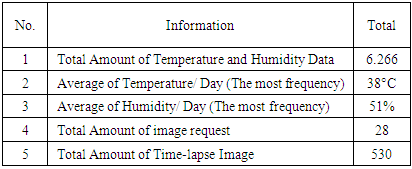-
Paper Information
- Paper Submission
-
Journal Information
- About This Journal
- Editorial Board
- Current Issue
- Archive
- Author Guidelines
- Contact Us
International Journal of Internet of Things
2018; 7(1): 16-21
doi:10.5923/j.ijit.20180701.03

Internet of Things: Control and Monitoring System of Chicken Eggs Incubator Using Raspberry Pi
I. Gusti Putu Sena Sila Adnyana, I. Nyoman Piarsa, Kadek Suar Wibawa
Department of Information Technology, Faculty of Engineering Udayana University, Bukit Jimbaran, Indonesia
Correspondence to: I. Gusti Putu Sena Sila Adnyana, Department of Information Technology, Faculty of Engineering Udayana University, Bukit Jimbaran, Indonesia.
| Email: |  |
Copyright © 2018 The Author(s). Published by Scientific & Academic Publishing.
This work is licensed under the Creative Commons Attribution International License (CC BY).
http://creativecommons.org/licenses/by/4.0/

Chicken breeders usually control and monitor their chicken eggs incubator machine manually and periodically to ensure the hatching process run well, it causes an inefficient time and energy. In order to avoid that, chicken eggs incubator machine is made with modern technology and make the duties of chicken farmer easier. Technology of “internet of things” allows the chicken breeders to control and monitor it in distance by using internet optimally in doing their job. Using Microcontroller Raspberry Pi technology which is combined with temperature and humidity sensors, light sensor, motor servo, webcam, and relay to produce control and monitoring system of chicken eggs incubator machine which can be accessed through website.
Keywords: Internet of Things, Chicken Eggs Incubator Machine, Raspberry Pi
Cite this paper: I. Gusti Putu Sena Sila Adnyana, I. Nyoman Piarsa, Kadek Suar Wibawa, Internet of Things: Control and Monitoring System of Chicken Eggs Incubator Using Raspberry Pi, International Journal of Internet of Things, Vol. 7 No. 1, 2018, pp. 16-21. doi: 10.5923/j.ijit.20180701.03.
Article Outline
1. Introduction
- Many kinds of technology have been created by human to make it easier for them in doing their job. One of important technology that has already grown rapidly is internet. Role of internet in human everyday life become a part that cannot be separated, and then creates a concept about “internet of things”. Regarding to the analysis of McKinsey Global Institute [2], “internet of things” is a technology who allows to connect machines, equipment, and other physical things with network sensor and actuator to get data and manage its own performance, it allows the machine to collaborate and even do acts based on the new information that is gotten independently. Breeding is a business activity in breeding animal, especially chicken. Some chicken breeders usually use an equipment to incubate chicken eggs, it is called chicken eggs incubator, which the incubator itself applies a same way with natural hatching that is done by hen. Chicken eggs incubator can be found easily with many kinds of features which are offered with the amount of hatching capacity is diverse, but some of those incubators still work manually. The stability of temperature and humidity in egg hatchery will be less effective if the monitoring is done manually. The manual control has not efficient anymore for the chicken farmers because it spends much time. Therefore, it needs a modern chicken eggs incubator tool that make it easier for the farmer to control and monitor it anytime and anywhere.Solution that is needed to resolve that problem is creating a control and monitoring system of chicken eggs incubator based on “internet of things” which is worked automatically in doing control and monitoring of temperature and humidity in chicken eggs incubator. Internet users give an easiness to the breeders to control and monitor the chicken eggs incubator from distance. Chicken eggs incubator which is made, consists of microcontroller Raspberry Pi which is combined with temperature and humidity sensor, and also light sensor, which then give an output command to step motor, webcam, and relay. Data which are accepted by microcontroller Raspberry Pi, will be sent to the server through internet to be stored in database and accessed through website.
2. Related Work
- The research in [3] had arranged a device that could measure temperature in chicken eggs incubator and sent the data in form of temperature telemetrically. The device could send the data in distance anytime it was needed, it gave an easiness to people who wanted to monitor the chicken eggs incubator without oversee it all day. Telemetry device was consisted of two main parts, there are transmitter and receiver. Transmitter part consists of temperature sensor component, Arduino Uno R3, and RF Module Board 433 MHz. The main function of Arduino Uno R3 in the research was as data processing from temperature sensor and sent it to the receiver. The weakness of the research was data transmission used telemetry system that had a distance limitation caused by the using of radio wave. Besides, there was no temperature control in the incubator space and also the data that were sent are only temperature.The other research in [4] also made a same device by using a 60W light bulb that functioned to set the correct temperature for the eggs. DHT11 temperature and humidity sensor interfaced with Raspberry Pi is used to monitor the temperature and humidity in incubator machine. Stepper motor was used that rotated the egg turner and changed the position of the eggs. The status of the condition inside the incubator could be viewed remotely via cloud. An Android app was used to control the intensity of the light bulb by varying the duty cycle of PWM (in %) remotely. The difference was shown at temperature control through Android application by setting the intensity of the light bulb. Besides, the monitoring system that was made did not use web camera, so that users could not monitor the condition inside the incubator machine itself. The researches that had been mentioned above had a significant contribution in designing and manufacturing control system and monitoring of chicken eggs incubator machine. Some differences of those researches is in using website for controlling and monitoring system that give a flexibility for the users. The system can be accessed through any device who have an internet browser, which is different with Android application who can only be used on android smartphone. Feature of monitoring using web camera is a new development that functioned to make users be able to see the condition inside the incubator machine. It is not mentioned on the previous researches.
3. Research Methods
- Research methodology which is used in this research is SDLC (Software Development Life Cycle) method in form of waterfall model. The waterfall model is the most famous model among other approach models in SDLC method. It is a development model which works linearly and in sequence. It is also the first model formed. Every step should be finished before continue it to the next step.
 | Figure 1. Waterfall Life Cycle Model [1] |
4. System Overview
- System overview explains about components in system and how are those components connected. The main hardware component in the system is microcontroller Raspberry Pi, various sensors such as temperature sensors and humidity, light sensor, relay, web camera, and step motor.Figure 2 is a general overview of control and monitoring system of chicken eggs incubator. Application of the components which are found in it can be explained as follow.
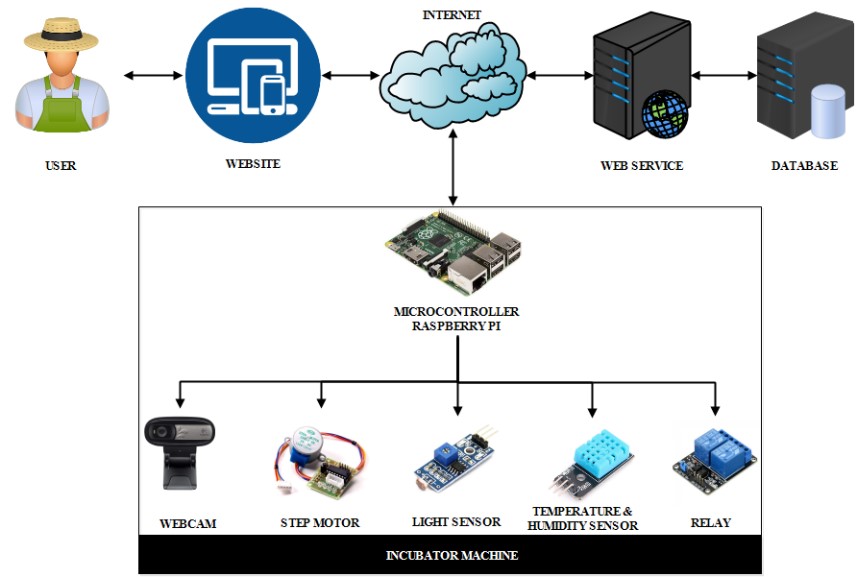 | Figure 2. General overview of control and monitoring system of chicken eggs incubator |
5. Prototype of Incubator Machine
- Prototype of incubator machine is made by using 30x30x40 cm wooden board that can contains six chicken eggs in once incubation process by using 15 watt of 2 incandescent bulb as the heat source, water pump as the humidity controller, and air fan for air circulation in the incubator space as shown on figure 3. The circuit of microcontroller Raspberry Pi that is connected with the webcam, step motor, light sensor, temperature & humidity sensor, and relay are placed at the top as shown on figure 4.
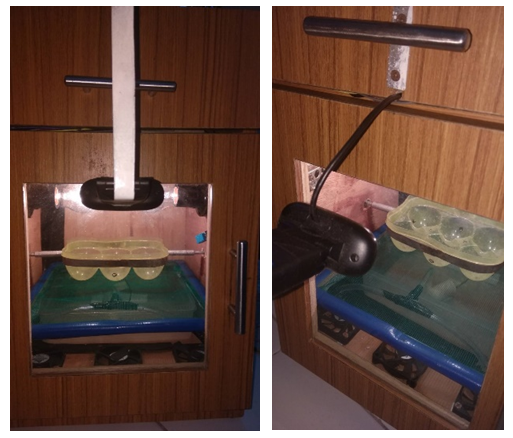 | Figure 3. Prototype of chicken eggs incubator machine from outside |
 | Figure 4. Prototype of chicken eggs incubator machine from inside |
6. Features of the Proposed System
6.1. Monitoring of Temperature, Humidity, and Light
- This feature is used to monitor the condition of the temperature, humidity, and light in chicken eggs incubator space. How this feature works is Raspberry Pi gets temperature data through temperature and humidity sensor, and also the light sensor. After those data obtained, then is checking the data condition which is empty or not. If the data obtained is not empty, it continues the encoding data process in form of UTF-8, and then send it to the server and save it in the database. If the data obtained is empty, it have to do retrieve the data. Website application provides a graphical user interface (GUI) to access that data. Sending data to the server is done every 5 minutes until the incubation process finish.
6.2. Automatic Control of Temperature and Humidity
- This feature is used to control temperature and humidity in chicken eggs incubator space to keep it stable at the normal level automatically. How this feature works is Raspberry Pi receives temperature data through temperature and humidity sensor. After the temperature data is received, then check the condition of the temperature itself. If the temperature is 38°C or up to that, it is called high temperature, SET GPIO.LOW process in Raspberry Pi pin that is connected to relay is done, so that the bulb will turn off. Temperature of 37°C or less than that is called low temperature, it means SET GPIO.HIGH process in Raspberry Pi pin that is connected to the relay is done, and the bulb will turn on. The data of humidity is received by checking the condition of the humidity itself. If the humidity is 51-60% is called normal. If it up to 60%, it is called a high humidity, then the SET GPOI. HIGH in Raspberry Pi pin process which is connected to the relay is done, so the water pump and air fan will turn off. If the humidity is only 50% or less than that, it means the humidity is very low, then the SET GPIO.LOW in Raspberry Pi pin process which is connected to the relay is done, so that the water pump and air fan will turn on. Beside that condition mentioned before, it is called abnormal condition, it can be happened because of the error when Raspberry Pi receives the temperature and humidity sensor from DHT11 sensor module.DHT11.
6.3. Automatic Turning of Egg Shelf
- This feature is used to turn the egg shelf automatically in order to the temperature spread evenly on all sides and also to make the egg embryo not stick to one side of the egg shell. How the feature works is the turning of egg shelf is done every six hours. First position of the egg shelf faces to the centre, then Raspberry Pi moves the step motor which is set to the fore with approximately 45° degree angle and remains in this position for six hours. After those six hours, the egg shelf will be moved by the step motor facing backward with approximately 45° degree angle and remains in this position for six hours, and then back to the first position in the centre. It happens repeatedly until incubator process stopped.
6.4. Taking Images
- This feature is used to monitor condition inside the incubator space by taking images using USB Web Camera. By using this feature, the condition inside the incubator space, whether the eggs have already hatched or not, is known by seeing the images that have already taken. Website application provides graphical user interface (GUI) to access this feature.
6.4.1. Taking Images through User Request
- The way of this feature works is taking and sending the images after user does request process on the website. Raspberry Pi read the request, the bulb will turn on first, and then the USB camera will also turn on and take the images. Those images will be stored in saving memory of Raspberry Pi, then are sent and stored in the server.
6.4.2. Taking Images Automatically
- The way of this feature works is taking and sending the images every once hour which is done automatically after incubation process is started. First thing to do is checking whether there is an incubation process or not, if there is an incubation process, the bulb turn on first, then the USB camera will also turn on and take the images. Those images will be stored in saving memory of Raspberry Pi, then are sent and stored in the server. This process is done repeatedly every once hour after the incubation process ended.
7. Results
- System and hatching experiment of chicken eggs were conducted at the same time to know which were the system and tools that had already made are success for chicken eggs incubator process or not and also to make it sure that the system was worked well or not.
7.1. System Experiment
- Control and monitoring system experiment of chicken eggs incubator machine is a test for system and the components inside the incubator machine. It is conducted to know which the system and its components used can be success.Figure 5 shows an information that can been seen by user through website. Its information is the time duration of incubation process that has been going on, temperature data, humidity, and light. On the figure, shown some data examples as the result of the first experiment.
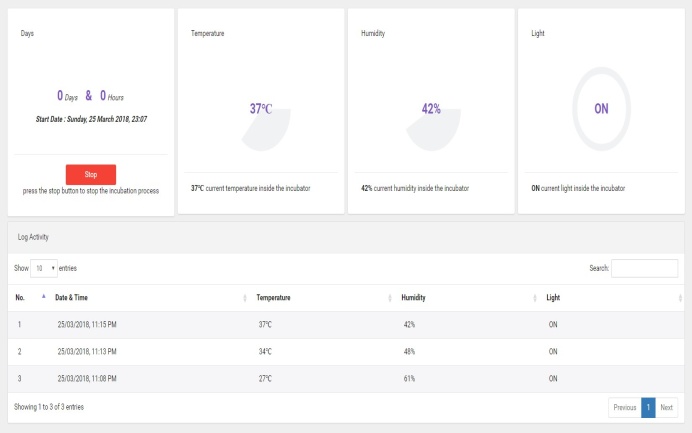 | Figure 5. Website display to show the data |
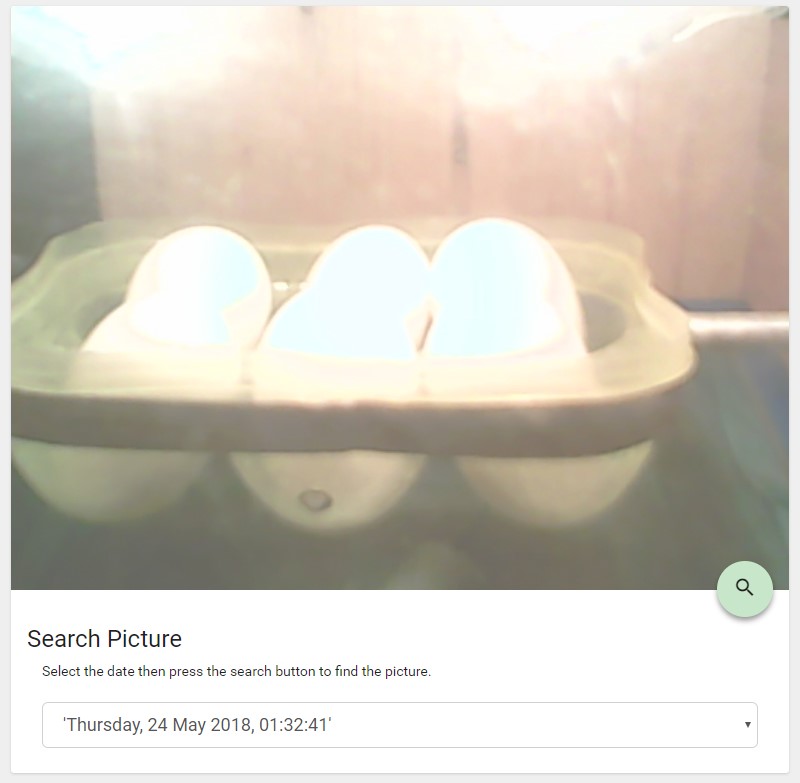 | Figure 6. Website display to show images which are taken from webcam |
|
7.2. Hatching Eggs Experiment
- Hatching chicken eggs experiment is conducted to know that the system and tools which are made is success to do the chicken eggs incubation process. It is done by using six eggs of local Bali chicken type that have been fertilized by rooster. The eggs used in the experiment have already passed the process of checking eligibility to minimize hatch failure. The experiment is conducted for 23 days with the result of four hatching eggs and two eggs failed to hatch. Those eggs that have failed to hatch after the checking is known that its embryo has grown but failed to grow.
8. Conclusions
- Control and monitoring system of chicken eggs incubator machine by applying “internet of things” technology using Raspberry Pi has succeed to be conducted. This system gives solution to the chicken breeders that it gives an easiness in monitoring and controlling process of incubator machine and also an easiness in hatching chicken eggs process so they can work efficiently. By using this system, they can control and monitor through their own incubator machine anywhere and anytime. Using website application as graphical user interface (GUI) gives an easiness to use this system because it can be accessed through internet browser from various devices, such as smartphone, tablet, desktop computer, and others. In the future, it hopes that the system can be developed to the bigger scale by using more modern and complex components completed with a better technique. For example is making the same machine with bigger amount capacity and also using better set technique of temperature and humidity.
 Abstract
Abstract Reference
Reference Full-Text PDF
Full-Text PDF Full-text HTML
Full-text HTML